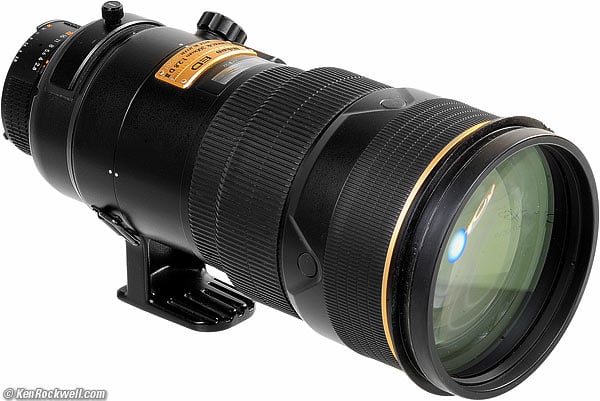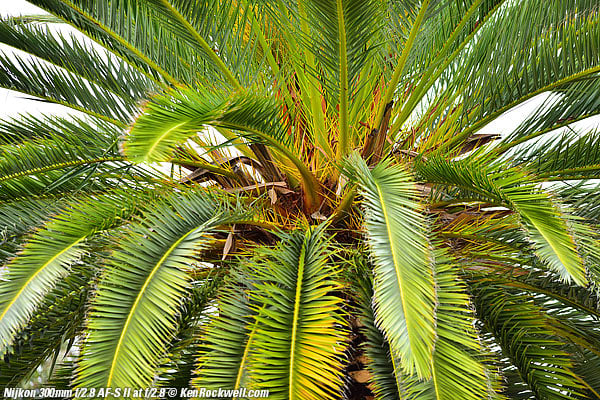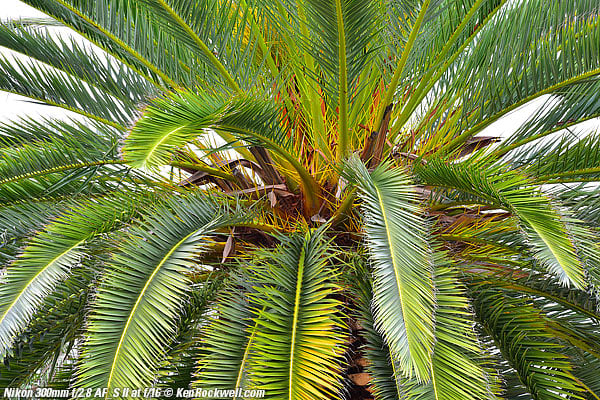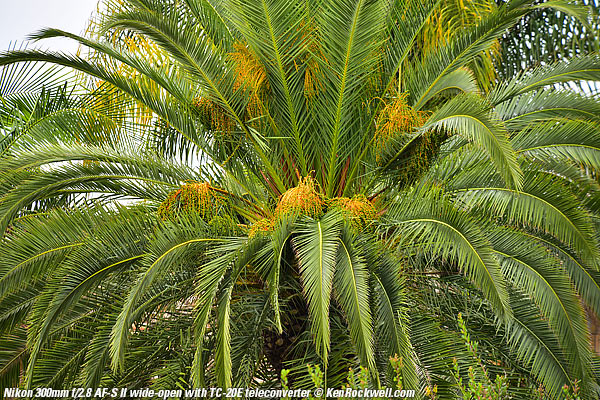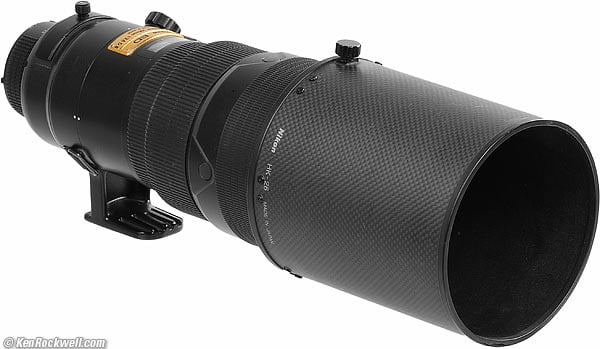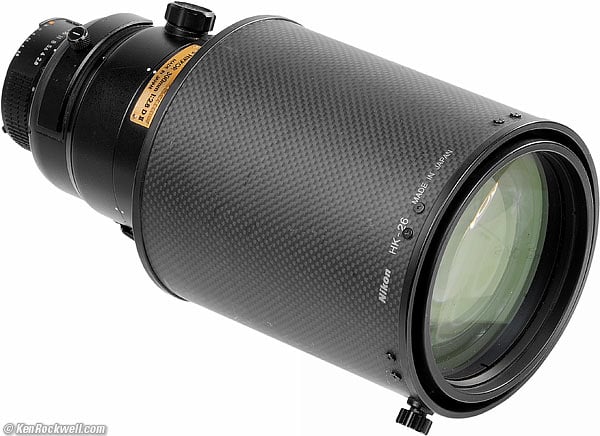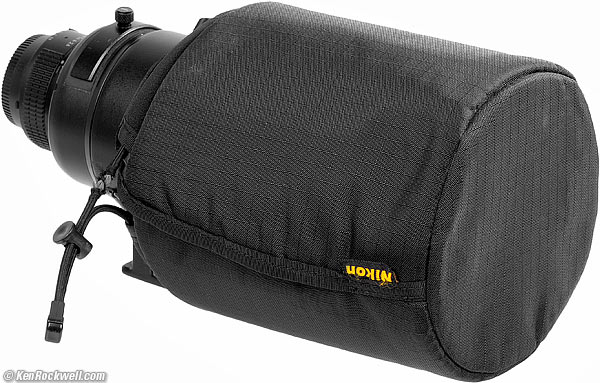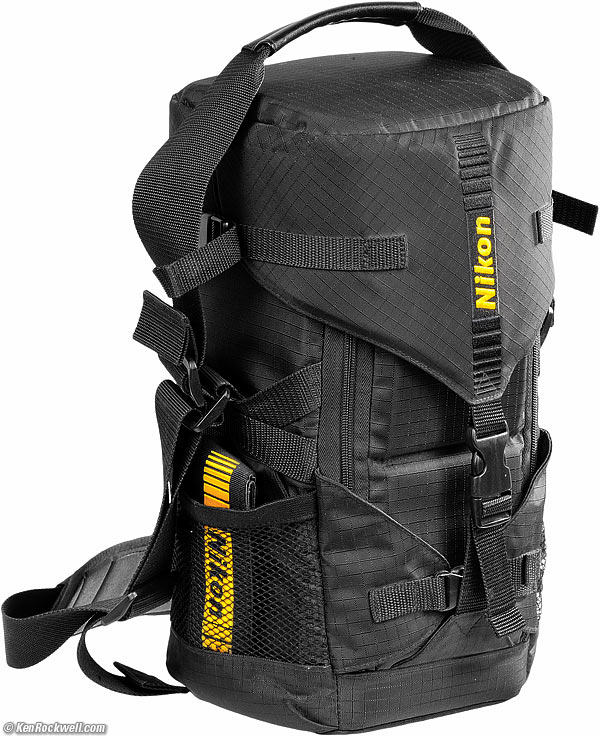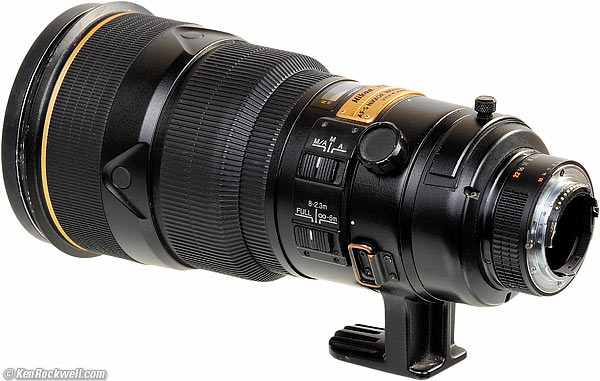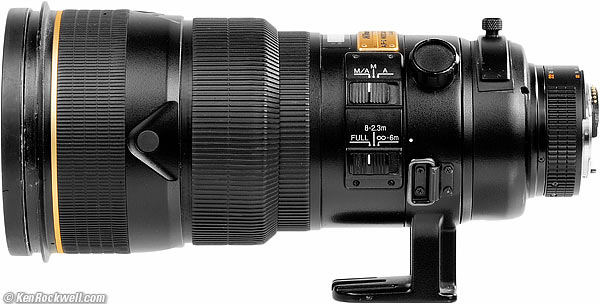Home Donate New Search Gallery Reviews How-To Books Links Workshops About Contact
Nikon 300mm f/2.8 AF-S II
NIKKOR ED IF
(2001-2004)
© 2014 KenRockwell.com. All rights reserved.
Introduction Sample Images Specifications
Performance Usage Compared Recommendations
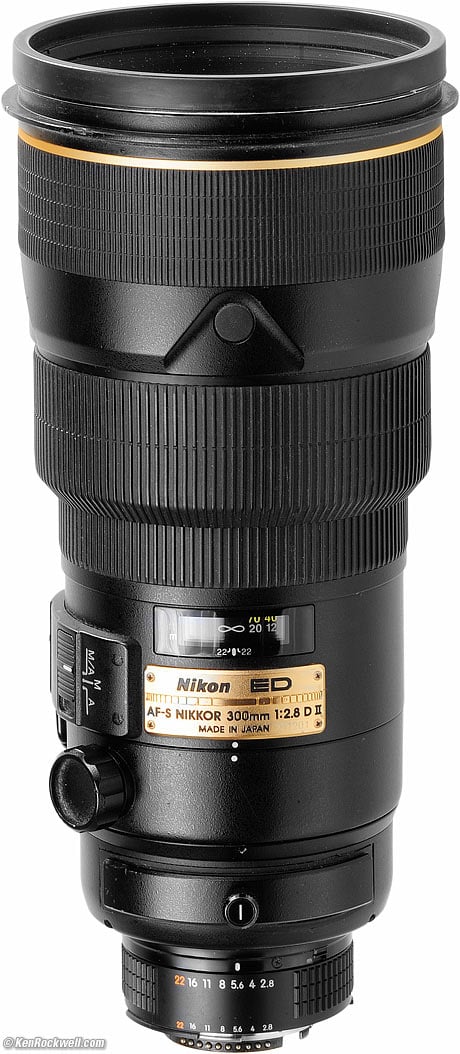
Nikon 300mm f/2.8 AF-S II.(FX, DX and 35mm coverage, 52mm drop-in filters, 90.75 oz./2,570g, 7.2'/2.2m close focus, about $2,700 used). I'd get it at this link directly to them at eBay (see How to Win at eBay).
This all-content, junk-free website's biggest source of support is when you use those or any of these links to approved sources when you get anything, regardless of the country in which you live — but I receive nothing for my efforts if you take the chance of buying elsewhere. I get no government hand-outs and run no pledge drives to support my research, so please always use any of these links to approved sources for the best prices, service and selection whenever you get anything. Thanks for helping me help you! Ken.
December 2014 Nikon Reviews Nikon Lens Reviews All Reviews
Why Fixed Lenses Take Better Pictures
All Nikon 300mm f/2.8 Lenses Compared
Introduction top
Introduction Sample Images Specifications
Performance Usage Compared Recommendations
Compatibility History Production
This 300mm f/2.8 stands out from the other Nikon 300mm f/2.8 lenses Nikon has made since 1971 because this AF-S II version is the lightest autofocus 300/2.8 ever made by Nikon, and no Nikon 300/2.8 focuses closer. You can grab the focus ring for instant manual-focus override in M/A mode, or lock it into manual-only (M) or Auto-only (A) modes.
This AF-S II lens focuses super-fast, and has superb optics.
This is Nikon's newest 300mm f/2.8 with an aperture ring, making it compatible with almost every Nikon ever made, unlike the newer G and VR lenses.
This 300/2.8 has no VR, but so what: VR is for wimpy f/5.6 zooms. With a 300/2.8, you're shooting action for which VR can't help, and when shooting portraits you're at f/2.8 where you're at super-fast shutter speeds. This lens' weight is all at the front, so it has a very large moment of inertia and self-stabilizes itself when hand-held.
Nikon has been making 300mm f/2.8 lenses for many decades (see them all compared). 300mm f/2.8 lenses are a professional standard for portraiture and sports, with far better background blur than any 70-200/2.8 zoom and loads of speed and reach for shooting under any lighting condition. As a fast f/2.8 lens, it works great with Nikon's TC-14E, TC-17E, TC-20E teleconverters (and newer versions of the same), with fast autofocus and great sharpness. The 300/2.8 has such insane sharpness and fast autofocus that it's still sharp and focuses well with even the TC-20E teleconverter.
The newer, heavier VR lenses are better only if you are shooting subjects that are holding still and you're shooting hand-held. That's not what most people do with 300/2.8s. For most of what people do with 300/2.8s, this is a better lens than the VR lenses because it weighs less and is more likely to work with older cameras.
This 300mm f/2.8 is so lightweight that it's easy to shoot hand-held.
Everything works perfectly on every digital Nikon ever made, both FX and DX, from the best Df, D4s, D810, D750 and D610 to Nikon's cheapest digitals like the D40, D40x, D60, D3000, D3100, D3200, D3300, D5000, D5100, D5200 and D5300.
It's also perfect on 35mm cameras like the F6, F100, F5, N90s, N80, N75, N70, F4, F3, F2AS, FE, FA and almost every other Nikon made since 1977.
The only incompatibility is that it won't autofocus with the cheapest new AF 35mm cameras like the N55 or the oldest 1980s AF cameras like the N2020, N6006 and N8008. No worries, these cameras have in-finder focus confirmation dots to help you, and everything else works great.
If you have a coupling prong added to the diaphragm ring, it's perfect with every Nikon back to the original Nikon F of 1959, otherwise, stick to cameras newer than 1977 for meter coupling.
See Nikon Lens Compatibility for details on your camera. Read down the "AF-S, AF-I" column for this lens.
See Nikon 300mm f/2.8 History.
Nikon made about 6,000 of these AF-S II lenses.
Nikon 300mm f/2.8 AF-S II. enlarge.
Sample Images top
Introduction Sample Images Specifications
Performance Usage Compared Recommendations
Palm at f/2.8, overcast, 16 December 2014. Nikon D810 at ISO 100, f/2.8 at 1/125. Camera-original file. Only the center is actually in focus.
Palm at f/16, overcast, 16 December 2014. Nikon D810 at ISO 100, f/2.8 at 1/125. Camera-original file. Even at f/16, only the center is in perfect focus.
A different palm shot with the TC-20E wide open, 16 December 2014. Nikon D810 at ISO 100, f/5.6 (wide-open) at 1/30. Camera-original file. At an effective 600mm, only the center is in focus.
Specifications top
Introduction Sample Images Specifications
Performance Usage Compared Recommendations
Name top
Nikon calls this the Nikon ED AF-S NIKKOR 300mm f/2.8 D II.
ED: Magic Extra-low Dispersion glass for reduced secondary chromatic aberration.
AF-S and SWM: Silent Wave Autofocus Motor.
NIKKOR: Nikon's brand name for all their lenses.
D: Couples distance information to the Matrix Meter.
Also has:
IF: Internal focusing; nothing moves externally as focused.
Optics top
11 elements in 8 groups.
3 are of ED Extra-low Dispersion glass.
It has a flat front plate permanently attached, much less expensive to replace if you break it.
It's multicoated, which Nikon calls Nikon Integrated Coating.
Diaphragm top
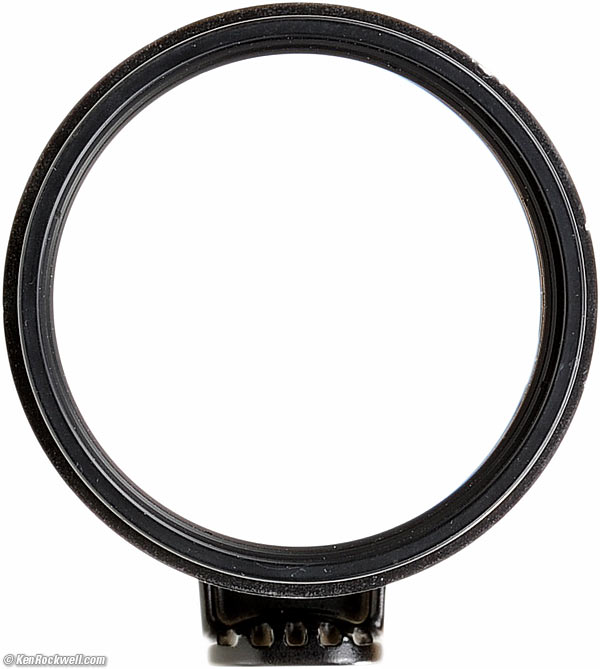
Nikon 300mm f/2.8 AF-S II at f/2.8.
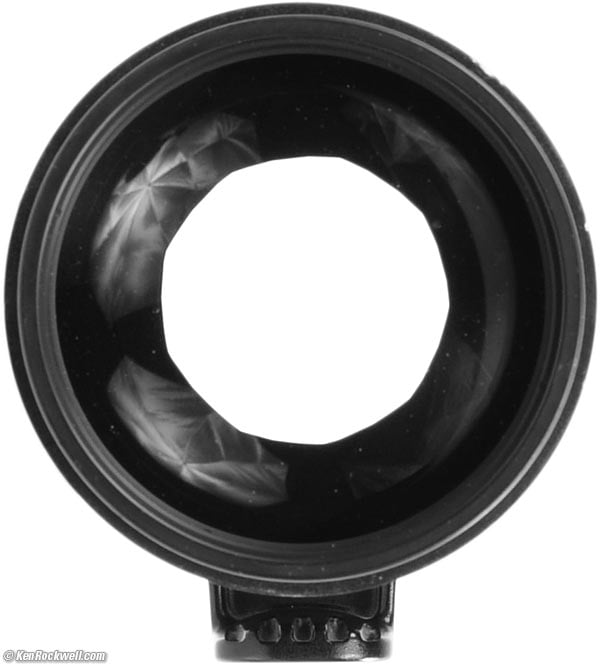
Nikon 300mm f/2.8 AF-S II at f/5.6.
9 rounded blades.
Stops down to f/22.
Round to f/5.6.
Straight-sided at f/16 and f/22.
Coverage top
Focal Length top
300mm.
When used on a DX camera, it sees angles of view similar to what a 450mm lens sees when used on an FX or 35mm camera.
Angle of View top
8.2° on FX digital and 35mm.
5.3° on small-format DX.
Close Focus top
7.2 feet (2.2 meters) from the image plane, marked.
Nikon specifies only 7.5'/2.3m in autofocus, but I didn't notice any difference in different focus modes.
Maximum Reproduction Ratio top
1:6.1 (0.164x) at 2.2 meters.
1:6.4 (0.156x) at 2.3 meters.
Hard Infinity Focus Stop? top
No.
You have to let the AF system focus at infinity.
Focus Scale top
Yes.
Depth-of-Field Scale top
Sort of; only two tiny ticks for f/22.
Infra-Red Focus Index top
No.
Aperture Ring top
Yes.
Full-stop clicks.
Tripod Collar top
Yes.
Does not come off.
Filter Holder top
Drop-in rear holder for 52mm screw-in filters.
Size top
Nikon specifies 4.9" (124 mm) diameter by 10.6" (269 mm) extension from flange (10.8" or 274 mm overall).
Weight top
90.75 oz. (5 lbs. 10.75 oz. or 2,570g), actual measured, lens only without hood or caps.
The hood weighs 6.305 oz. (178.8g).
The lens and hood weigh 97 oz. (2,750g) together.
The front sock cap weighs 4.560 oz.(129.3g).
The lens with both caps and hood weighs 101.75 oz (6lbs 5.75oz or 2,885g).
The lens, case, hood, caps and straps weigh 155 oz. (9lb 11oz or 4,400g).
Nikon specifies 90.3 oz. (2,560 g).
Hood top
It comes with a carbon-fibre-look HK-26 hood. It attaches with a thumb screw, and it reverses. For all I know, maybe it really is carbon fibre.
The hood weighs 6.305 oz. (178.8g).
Nikon 300mm f/2.8 AF-S II with HK-26 hood. enlarge.
Nikon 300mm f/2.8 AF-S II with reversed HK-26 hood. enlarge.
Caps top
The front cap is a padded nylon cover with a drawstring.
If covers the hood in either the extended or reversed position.
It weighs 4.560 oz.(129.3g).
Nikon 300mm f/2.8 AF-S II with soft padded cap. enlarge.
Case top
The CL-L1 padded nylon case (shown) is fantastic. It's a tough, lightweight case with pockets to put everything.
There's also a CT-305 roadie-style trunk case.
CL-L1 Case, Nikon 300mm f/2.8 AF-S II. enlarge.
Quality top
Made in Japan.
Case made in China.
Teleconverters top
TC-14E, TC-17E, TC-20E (and newer versions of the same) teleconverters work great. The resulting 420mm f/4, 510mm f/4.8 and 600mm f/5.6 combinations are sharp and focus quickly.
Even with the TC-20E, AF is fast and sure, nailing perfect focus quickly with no wavering.
Manual focus TC-300/301 and TC-14B teleconverters also work swell, with only manual focus of course. These make the lens look like a manual focus lens, so you'll only have the exposure modes your camera gives with manual focus lenses.
Price, USA top
December 2014: about $2,700 used.
Performance top
Introduction Sample Images Specifications
Performance Usage Compared Recommendations
Overall Autofocus Bokeh Color Distortion
Ergonomics Eyeblow Falloff Filters Focus Breathing
Lateral Color Fringes Macro Mechanics Sharpness
Sunstars Survivability Tripod Collar
Overall performance top
The Nikon 300mm f/2.8 AF-S II Nikon's best 300/2.8 for many purposes, unless you really need VR. Newer lenses aren't any sharper, but are heavier.
Autofocus performance top
Autofocus is fantastic. As one of Nikon's top professional lenses, Nikon makes its reputation with this lens, and spared no expense in making it fast, quiet and accurate.
Manual focus is swell. The focus ring is huge.
There are four AF-lock buttons around the front for even easier and faster shooting.
Bokeh performance top
Bokeh, the character of out of focus backgrounds, not simply how far out of focus they are, is beautiful at all apertures.
Here are full-frame shots made at 15 feet (4.5 meters), a typical headshot distance:


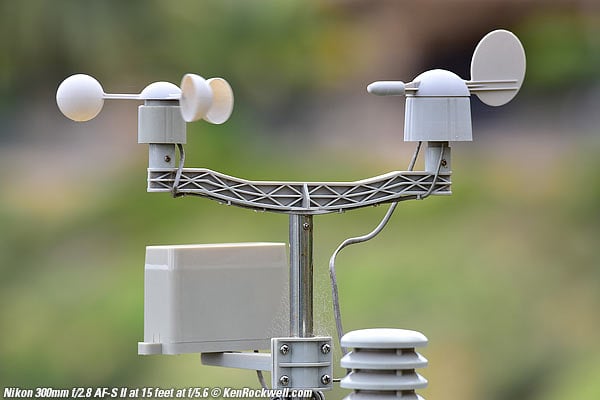
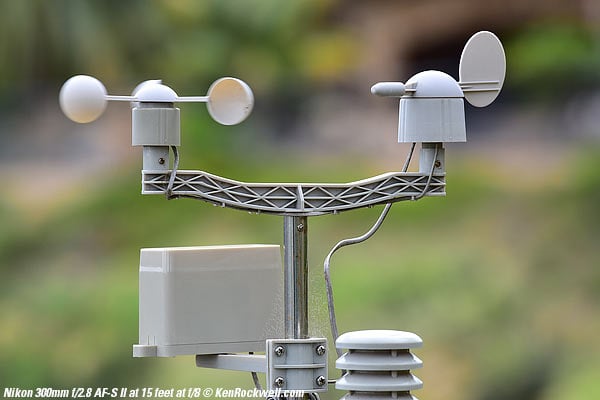

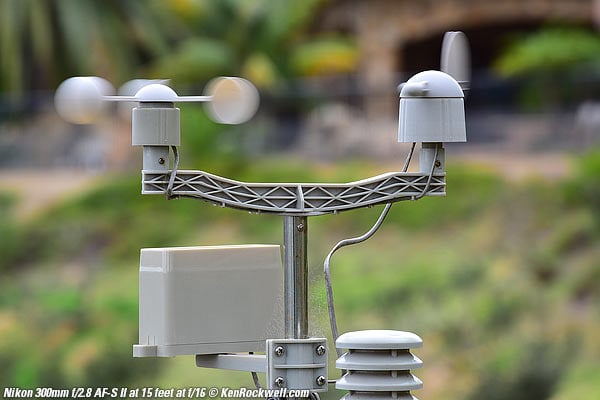
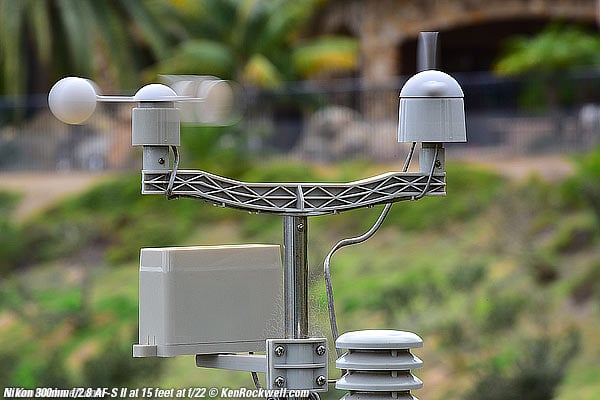
Color Rendition performance top
The color rendition is the same as my other Nikkor AF lenses.
Distortion performance top
The Nikon 300mm f/2.8 AF-S II has no visible distortion.
For more critical use, use these figures to correct the minor pincushion distortion in Photoshop's lens distortion filter. These aren't facts or specifications, they are the results of my research that requires hours of photography and calculations on the resulting data.
100' (30m) |
-0.9 |
30' (10m) |
-0.9 |
10' (3m) |
-1.0 |
© 2014 KenRockwell.com. All rights reserved.
Newer digital cameras like the D90, D3100, D3200, D3300, D5000, D5100, D5200, D5300, D7000, D7100, D4, D4s, D600, D610, D750, D800, D800E, D810 and Df can be set to correct the distortion automatically in-camera. I didn't try this.
Ergonomics (handling and ease-of-use) performance top
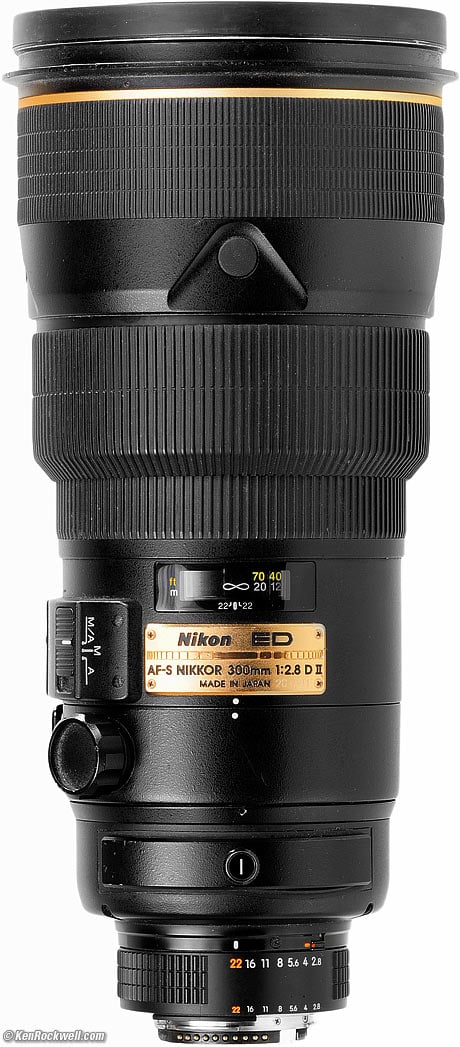
Nikon 300mm f/2.8 AF-S II.
Ergonomics are wonderful. This huge lens is easy to hold and to handle.
See the four buttons on the front? Those are focus-lock buttons.
Eyeblow performance top
Focus is internal.
No air blows in or out as focussed.
Falloff (darkened corners) performance top
Falloff on FX and 35mm is minor at f/2.8, and gone by f/4.
It won't be an issue at all on DX (see crop factor).
I've exaggerated this by shooting a gray field and placing these on a gray background:
Nikon 300mm f/2.8 AF-S II falloff on FX and 35mm at infinity, no correction.
© 2014 KenRockwell.com. All rights reserved.
|
Filters, use with performance top
Filters screw into a removable holder towards the back of the lens.
Use regular Nikon 52mm filters; other brands of 52mm filters may be too thick to fit.
Nikon makes a special C-PL1L (Nikon product number 2474) drop-in polarizer.
Focus Breathing performance top
Of interest mostly to cinematographers focusing back and forth between two subjects, the image from the Nikon 300mm f/2.8 AF-S II gets larger as focused more closely.
Lateral Color Fringes performance top
There are no lateral color fringes on the D810, which corrects whatever there may be automatically.
Macro performance top
It focuses super-close for a 300/2.8, but its images are no bigger than with most other lenses:
Full-frame image at f/2.8 at close-focus distance.
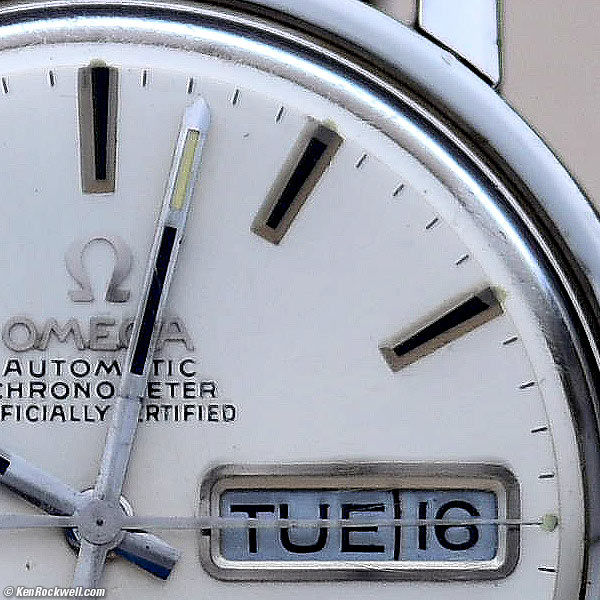
Crop from above 36 MP image at 100%. If this is 6" wide on your screen, the complete image printed at this same magnification would be 75 x 50." (6 x 4 feet, or 2 x 1.25 meters!)
It's super-sharp even at f/2.8 at its closest focus distance, and AF is also super-accurate.
Mechanics and Construction performance top
Nikon 300mm f/2.8 AF-S II. enlarge.
The Nikon 300mm f/2.8 AF-S II is a top pro lens. It's built as well as any Nikon lens today, and far better than Nikon's $1,500 consumer lenses.
Hood
Looks like carbon-fibre.
Hood Mount
Metal.
Front Barrel
All metal.
Focus Ring
Metal; rubber covered.
Mid Barrel
Metal.
Tripod Collar
All metal.
Internals
Metal.
Filter Holder
All metal.
Barrel exterior around filter holder
Plastic.
Aperture Ring
Plastic with painted numbers.
Mount
Dull-chromed brass.
Markings
Paint.
Mounting Index
Black-headed screw on mount face.
Identity Plate
Engraved 14k gold.
Serial Number
Engraved on identity plate.
Moisture seal at mount
No.
Noises When Shaken
Clicking from the diaphragm blades and actuation system.
Made in
Japan.
Sharpness performance top
Warning 1: Image sharpness depends more on you than your lens.
Warning 2: Lens sharpness doesn't mean much to good photographers.
While amateurs waste time worrying about lens sharpness, pros know that lens sharpness has little to do with making sharp pictures. This said, the Nikon 300mm f/2.8 AF-S II is among Nikon's sharpest lenses.
Presuming your subject is perfectly flat or all at infinity, this lens is ultra-sharp even wide-open at f/2.8 from edge to edge on full-frame at 36 MP.
Of course diffraction limits performance at small apertures, but other than that, if you can't make stunningly sharp pictures with this lens, you're not doing it right.
Sunstars performance top
With its rounded diaphragm, I don't expect to see sunstars on brilliant points of light.
To see any, try shooting at f/16 or smaller.
Survivability performance top
The Nikon 300mm f/2.8 AF-S II tough. The only conceivable problem you could have is if the AF-S motor dies and Nikon can't supply a replacement. No worries, even with a dead AF motor, manual focus works fine.
Tripod Collar performance top
The all-metal collar has nearly no play when loosened.
The lock knob works well, locking rotation without much force needed.
There are no 90º click stops.
Usage top
Introduction Sample Images Specifications
Performance Usage Compared Recommendations
M/A - M - A Switch
Nikon 300mm f/2.8 AF-S II. enlarge.
The "M/A" position is the normal position.
In "M/A" the lens autofocuses, and if you grab the ring, you get instant manual override
"M" disables autofocus. It's always in manual focus.
"A" disables manual focus. Even if you turn the ring, it won't focus the lens.
AF Lock Buttons
The four buttons around the front are focus-lock buttons.
Hold them, and AF locks. Use this either for recomposing, or if your subject is temporarily obstructed while running down the field.
Hand-Holding
Hand-holding is easy. You may or may not want to put your right hand on the hood instead of the lens body if you trust the hood not to fall off.
If you trust it, you'll earn yourself some extra leverage and stability by holding it by the hood.
Teleconverters
This lens works great with Nikon's TC-xxE series of converters of any age.
Monopods
If you're not up to hand-holding, a monopod is the smartest idea for most shooting. It gives you most of the freedom of hand holding, with much of the stability of a tripod — and the monopod holds all the weight. Unlike a tripod, a monopod is easy to tote along with the lens.
Mirror Lock Up
As with all ultra-telephotos, results are usually blurred at around 1/30 on a tripod due to mirror-slap if you don't use mirror lock up.
Use the MLU mode, usually found on the camera's top dial, and results are now super-sharp, even with a 2x teleconverter.
Compared top
Introduction Sample Images Specifications
Performance Usage Compared Recommendations
This is the lightest Nikon 300mm f/2.8 autofocus lens of all time. It's light enough to want to hand hold, and no Nikon 300/2.8 focuses closer or faster.
See also All Nikon 300mm f/2.8 Lenses Compared.
Any 300/2.8 is sharper and can thrown backgrounds out of focus better than any 70-200/2.8 zoom.
There isn't that much optical difference between this lens and the 300mm f/4 AF-S. One stop doesn't make much difference in background softness. If you don't plan to use teleconverters, consider the 300/4 for half the price of this lens. The 300/4 focusses even closer.
This AF-S II lens is very similar to the first Canon EF 300mm f/2.8 L. This AF-S lens focuses closer and weighs less.
Recommendations top
Introduction Sample Images Specifications
Performance Usage Compared Recommendations
The Nikon 300mm f/2.8 AF-S II is a top pick for any professional use for sports, nature, landscape and portraiture. It's fast, long, ultrasharp, has fantastic bokeh, focuses just about instantly and is Nikon's lightest autofocus 300/2.8 of all time — and no 300/2.8 focuses closer.
In addition to being optically superior, another reason to own a 300/2.8 is to earn credibility in an extremely competitive world. When you show up to a portrait shoot, arts or sports venue with a 300/2.8 slung over your shoulder, especially with its big carbon-fibre hood in the operating position, you've defined yourself as an accomplished professional. You earn both the respect you deserve, as well as often being able to gain access to pros-only areas right down on the field, or in the press box. See Phil Steele's Event Photography tutorials for his secret ninja photographer tricks to use this lens to get you into concert and sports events. Never lie about who you are or what you're doing, but play your cards professionally and skilled shooters usually can get their way into VIP areas for free. Everyone has a 70-200/2.8. That won't set you apart, but when you show up to a shoot with your 300/2.8, everyone knows they hired the right guy, and this can get you more work next time from more people.
Photographically, a 300/2.8 throws backgrounds much further out of focus than a 70-200 does at 200mm. This is why pros use the 300/2.8 as a portrait and headshot lens. It lets us stand farther away for better facial rendering (perspective), and at f/2.8 blows-out any annoying background into a wall of soft color far better than any 200mm lens can at f/2.8.
The 300/2.8 has been a favorite of newsmen and paparazzi for ages. A 300/2.8 was used back in the 1970s by a newsman to shoot over the shoulder of Henry Kissinger and expose a secret document he was reading at a meeting, back when no one thought anyone could photograph something that small that far away in light that dim and still make it legible. Today, 300/2.8s are favorites of paparazzi who carry them with an attached body in a generic cloth shoulder shopping bag, ready to be drawn and fired the instant an unsuspecting subject appears.
A 300mm f/2.8 is the most useful super-tele because it can do so much more than the longer, slower super teles. 1.4x, 1.7x or 2x converters make your 300/2.8 into a 420/4, 510/4.8 or 600/5.6, with great sharpness and autofocus, but if you bought a 400/4 or 600mm lens, you can't make it shorter or faster — but you always can take an extender off the 300/2.8. A 400/2.8 also works as well with extenders and is therefore also very versatile if you can afford just one super-tele.
A 300/2.8 is the lightest super-tele. A 400/2.8 or longer lens gets much heavier. This 300/2.8 is about the heaviest lens a sane man will want to hand-hold.
VR is a feature not really needed for a 300/2.8. We use 300/2.8s for sports, for which VR is of no help, or on a tripod, or shooting wide-open at fast shutter speeds, again for which VR is of no help.
Unless you really need VR, which only helps for photographing still subjects hand-held, or need an even older lens to get a standard 9-bladed diaphragm for better sunstars for cityscapes at night, this AF-S II is the 300mm f/2.8 lens to get, for half the price of a new VR version.
I'd get it at this link directly to them at eBay (see How to Win at eBay).
This all-content, junk-free website's biggest source of support is when you use those or any of these links to approved sources when you get anything, regardless of the country in which you live — but I receive nothing for my efforts if you take the chance of buying elsewhere. I get no government hand-outs and run no pledge drives to support my research, so please always use any of these links to approved sources for the best prices, service and selection whenever you get anything.
Thanks for helping me help you!
Ken.
Help me help you top
I support my growing family through this website, as crazy as it might seem.
The biggest help is when you use any of these links when you get anything, regardless of the country in which you live. It costs you nothing, and is this site's, and thus my family's, biggest source of support. These places have the best prices and service, which is why I've used them since before this website existed. I recommend them all personally.
If you find this page as helpful as a book you might have had to buy or a workshop you may have had to take, feel free to help me continue helping everyone.
If you've gotten your gear through one of my links or helped otherwise, you're family. It's great people like you who allow me to keep adding to this site full-time. Thanks!
If you haven't helped yet, please do, and consider helping me with a gift of $5.00.
As this page is copyrighted and formally registered, it is unlawful to make copies, especially in the form of printouts for personal use. If you wish to make a printout for personal use, you are granted one-time permission only if you PayPal me $5.00 per printout or part thereof. Thank you!
Thanks for reading!
Mr. & Mrs. Ken Rockwell, Ryan and Katie.
Home Donate New Search Gallery Reviews How-To Books Links Workshops About Contact



